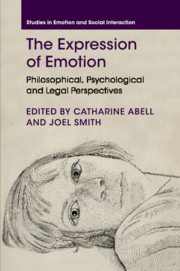Book contents
- Frontmatter
- Contents
- Notes on Contributors
- Acknowledgements
- Introduction: Emotional Expression
- Part I Philosophical Perspectives
- Part II Psychological Perspectives
- Part III Legal Perspectives
- 11 Regulating the Expression of Remorse and the Building of Moral Communities
- 12 Share Your Grief but Not Your Anger: Victims and the Expression of Emotion in Criminal Justice
- 13 Performing Anger to Signal Injustice: The Expression of Anger in Victim Impact Statements
- Index
- Miscellaneous Endmatter
- References
11 - Regulating the Expression of Remorse and the Building of Moral Communities
from Part III - Legal Perspectives
Published online by Cambridge University Press: 05 September 2016
- Frontmatter
- Contents
- Notes on Contributors
- Acknowledgements
- Introduction: Emotional Expression
- Part I Philosophical Perspectives
- Part II Psychological Perspectives
- Part III Legal Perspectives
- 11 Regulating the Expression of Remorse and the Building of Moral Communities
- 12 Share Your Grief but Not Your Anger: Victims and the Expression of Emotion in Criminal Justice
- 13 Performing Anger to Signal Injustice: The Expression of Anger in Victim Impact Statements
- Index
- Miscellaneous Endmatter
- References
Summary
Introduction
This chapter builds on earlier research that the present writer and others have conducted over the past fifteen years into the critical role that expressions and attributions of different emotions play in legal decision making in general and in criminal law in particular. That law, despite its frequent portrayal as free of distracting passions, as nevertheless an instrument for the communication of these passions, is a conundrum that has now been explored with reference to shame, disgust, anger and other powerful emotions. My research has contributed to this growing corpus by looking at the importance attached to expressions of remorse in decisions about sentencing and parole in Canada and the United States, and how the crediting or discrediting of these expressions creates a moral hierarchy of those who are remorseful and those who are without remorse that has far-reaching consequences for those transgressors so defined (Weisman 2009: 47–69). Perhaps the most graphic demonstration of the gravity and weight attached to these attributions stems from the work undertaken by the prolific National Capital Juror study in the United States. Numerous articles emanating from this project have attested to the importance jurors accord to the offender's show of remorse in deciding whether or not to impose the death penalty. In one of these studies involving California jurors in thirty-seven capital cases, it was found that 69 per cent of jurors who voted for death in the bifurcated penalty phase of the capital trial cited the absence of remorse by the defendant as the principal factor in their decision (Sundby 1998: 560). As of this writing, there is sufficient scholarship worldwide to suggest that similar concerns about remorse in which it is not just the transgressive act but the transgressor's feelings about the act play a major role in such disparate legal cultures as that of China, Japan, Sweden and the Netherlands, as well as in the common law jurisdictions of Canada, United States, England and Australia.
Although my work has participated in this surge of scholarly interest into how attributions of remorse figure into judicial decision making, it has also taken a different turn of which this chapter is an outgrowth.
- Type
- Chapter
- Information
- The Expression of EmotionPhilosophical, Psychological and Legal Perspectives, pp. 247 - 262Publisher: Cambridge University PressPrint publication year: 2016
References
- 1
- Cited by



